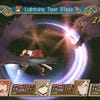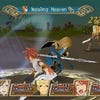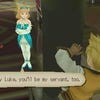Tales of the Abyss Review
Chasm Dave.
Talk of Japanese RPGs in Europe tends to be dominated by the obvious big names, the Final Fantasies and Dragon Quests. That's no surprise, given that a great many other series rarely - if ever - make it as far as European shores.
Namco Bandai's Tales is one such series, having clocked up 27 games and spin-offs, not to mention four animated TV shows, without leaving much of a dent in the European gaming consciousness. That may be partly down to the title - sticking "Tales of" in front a game is common enough practice that it makes connecting the dots tricky for anyone not already immersed in the series.
Tales of the Abyss was the eighth game in the series when it appeared on PlayStation 2, and its arrival here on 3DS marks not only its European debut but also the first pure-bred JRPG to arrive on Nintendo's new handheld. With Final Fantasy and Dragon Quest missing in action, it's a good opportunity for this venerable rival to steal some Western fans.
It's a well deserved opportunity as well, as Tales of the Abyss is a compelling example of its genre that manages to deviate from the expected formula often enough to surprise.
To begin with, however, it's clichés all the way. Our hero is Luke and, yes, he's a petulant teenager with a secret destiny and a mystery from his past shrouded by amnesia. The world is pitched somewhere between flamboyant Renaissance and steampunk sci-fi. Hair is brightly coloured and gravity-defying, regardless of gender. And, inevitably, there are cute animal things with magic powers.
It's a game steeped in its own stodgy lore, and it displays that slightly off-putting assumption that many JRPGs share: that you'll care enough about the reams of names, places and events being thrown at you to keep up as the plot rattles from one melodrama to the next. It's a game where characters bang on about things like "daathic fonic arte" without bothering to explain what that actually means. You either pick it up as you go, or throw up your hands and wander off in confusion.
So clearly this isn't a game that will win over anyone unimpressed by Japanese RPG design, but having established its roots, Tales of the Abyss at least finds new ways to grow its branches.
The pace is swift, at least in comparison to rival series. Within the first half-hour of play you'll have chomped through all the initial exposition, been given a crash course in combat and given the chance to freely explore the first overworld map. There's not much to find at first, but it gives the game an open-plan feel that most of its peers hold back until you've earned access to a magic train or flying ship in the second act.
In a genre where it's become common practice to bog the player down in reams of cut-scenes and text boxes, Tales of the Abyss knows when to shut up and let you decide how much background you want. After key events, you'll have the option to view "skits" - short conversation scenes that flesh out the motivations, history and feelings that might otherwise get in the way of the adventure. Don't want that extra detail? Then just ignore the prompt and get on with it.
Combat is similarly unrestrained by convention. No turn-based battle here, as you battle enemies in real time, using a basic side-on fighting game system (yes, it has a cumbersome official name: Flex Range Linear Motion Battle System) which enables you to slash, block, dodge and parry with arcade speed. You're locked into a horizontal Street Fighter-style plane while fighting, but can break out of that and run freely around the battle area with one of the early unlocks, while your team mates will chip in and help with varying degrees of autonomy.
It's a refreshing change from the norm, if a little blunt in execution. On the PS2 it was prone to button-mashing, and that's exacerbated by slightly gluey button response on the 3DS. Special attacks called "artes" can be earned and mapped to different button-and-stick combinations, while dozens of passive abilities can be equipped and activated as needed.
There are deeper evolutions that become available as the game progresses - including elemental "fon" powers that build up the more you use - but the game rather takes for granted that you'll discover and understand these finer details for yourself. On-screen explanations are minimal and menus filled with intricate details do little to entice anyone not already well versed in JRPG tradition.
If the game gets more complex as it goes on, it also becomes more interesting. The characters may slot neatly into archetypal holes, but they're well written and convincingly performed with a generous amount of English voice acting. Luke, in particular, proves to be one of the genre's more intriguing heroes as his evolution from spoiled brat to worthy hero is enjoyably organic.
So, at the very least, Tales of the Abyss is a solid and sometimes quite clever JRPG making its long-overdue debut for European players. The 3DS, of course, also adds 3D and the result is inessential but undeniably attractive. The game has some lovely architecture and a wide variety of environments, and the 3D effect is so well implemented that you'd swear it had been designed for it six years ago. It's even slightly useful in the battles, as it makes it a little easier to track multiple enemies and see when they're in striking distance.
Where the 3D lets the game down is during the text-only dialogue scenes. Speech bubbles float at the "front" of the screen, rather than level with the character speaking, which means your eyes are trying to focus in two places at the same time. The result is distracting and annoying, and led me to eventually switch the 3D down for those parts.
With no rivals on the platform, Tales of the Abyss didn't have to be spectacular to stand out - but even when the JRPG heavyweights get their inevitable 3D outings, Namco's charming and witty cult offering will still be worth playing.



































